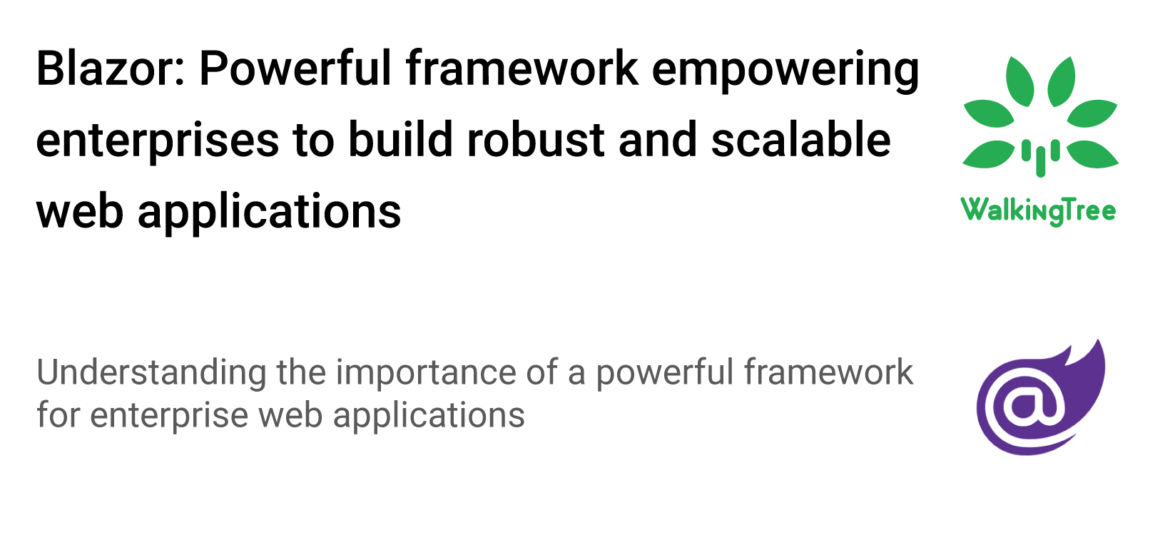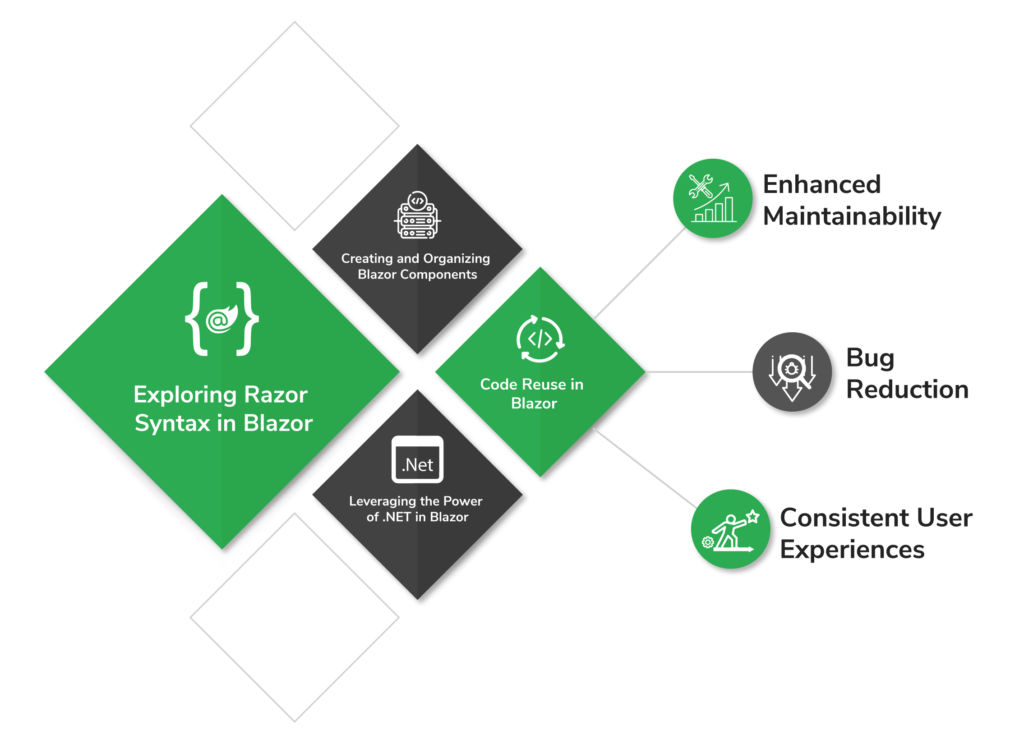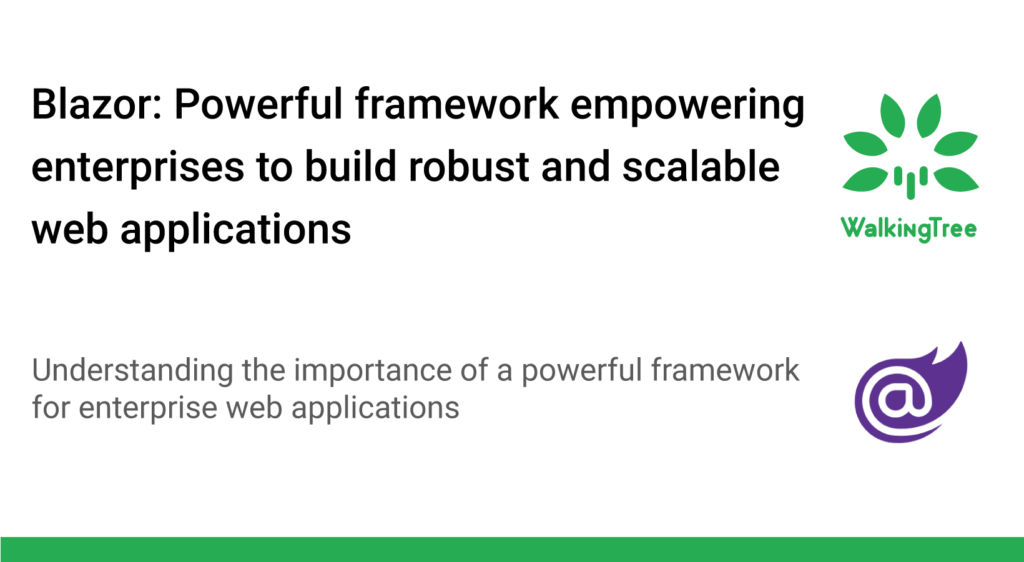
Utilization of a powerful framework helps enterprises in building robust and scalable web applications that meet their specific business requirements and ensure long-term success in the digital landscape.
Powerful frameworks are crucial for building enterprise web applications. But why?
Because they provide:
- Scalability to handle high user traffic.
- Customization options to meet specific business requirements.
- Robust security to protect sensitive data.
- Optimized performance for a seamless user experience.
- Seamless integration with existing systems.
- Enhanced developer productivity, and long-term maintenance and support.
Frameworks with such qualities empower enterprises to create robust and efficient web applications that align with their unique needs, ensuring business success in the digital landscape.
|Blazor: Building Modern Web Applications for Enterprises
A powerful framework is like a sturdy foundation for building enterprise web applications, providing the critical support needed for successful development and long-term sustainability.
Blazor is an incredible framework that has gained popularity in the realm of enterprise web application development. It offers developers the unique advantage of leveraging C# and .NET, enabling them to build interactive and high-performing web applications that seamlessly run on both the client and server sides. In our blog, we’ll delve into the fascinating world of Blazor, exploring its key features and demonstrating how it brings immense value to enterprises. So, let’s embark on this journey to discover the potential of Blazor in revolutionizing the way we build enterprise web applications.
|Blazor: An Overview of Its Hosting Models
Blazor simplifies web application development by offering two hosting models (server-side and client-side), a component-based architecture, and robust data binding capabilities, enabling developers to create interactive and reusable UI elements with ease.
Blazor offers two hosting models: server-side and client-side.
In the server-side model, the application’s UI is rendered on the server and then sent to the client using a SignalR connection. This hosting model is great for applications that require real-time updates and a persistent connection.
It’s especially useful for collaborative tools or applications where multiple users need to see changes in real-time.
On the other hand, the client-side model compiles the Blazor application into WebAssembly. This allows the application to run directly in the browser. The entire application can be downloaded to the client’s machine and executed locally.
One significant advantage of this model is that it supports offline scenarios. Applications can continue to run even when there’s no internet connection. Additionally, it reduces the dependency on the server. Most of the application logic is executed on the client side.
|Exploring the Blazor Component Model
Blazor follows a component-based architecture. The user interface (UI) elements are encapsulated into reusable components. These components can be nested and combined to create complex and interactive user interfaces.
It’s like building with LEGO bricks, where each component represents a specific functionality or visual element.
To define the UI and handle events within components, Blazor uses the Razor syntax. It’s quite similar to HTML. However, with the added power of C# functionality.
This combination allows developers to write expressive and dynamic code directly within the components. The use of the Razor syntax promotes code reusability, separation of concerns, and maintainability. It’s easier to manage and update individual components without affecting the rest of the application.
|Understanding Data Binding in Blazor
Blazor offers powerful data-binding capabilities. Enable seamless synchronization between the user interface (UI) and the application data. Data binding allows you to establish connections between components and data models ensuring that any changes in the data are automatically reflected in the UI, and vice versa.
With Blazor, you can implement both one-way and two-way data binding. One-way data binding enables you to display data in the UI without allowing user modifications. It’s useful for presenting information that doesn’t need to be updated by the user.
On the other hand, two-way data binding allows users to not only see the data but also modify it, with the changes being automatically synchronized between the UI and the data model.
By leveraging data binding, developers can build interactive user experiences that respond in real-time to user interactions. It simplifies the development process by eliminating the need for manual synchronization between the UI and the data model, ultimately enhancing productivity.
|Building Blocks of Blazor
Blazor utilizes Razor syntax to seamlessly combine HTML markup and C# code, allowing developers to create dynamic and efficient web applications. Components serve as the fundamental building blocks, enabling organized and maintainable code through a hierarchical structure.

One of the great things about Blazor is its Razor syntax. It allows you to mix HTML markup and C# code within the same file. It’s like having the best of both worlds! This powerful syntax enables you to dynamically render content, write conditional statements, loop over data, and even execute code.
Imagine being able to create dynamic UI elements that change based on certain conditions or display data from your backend.
With Razor syntax, you can easily achieve that. It helps you write clean and concise code by seamlessly integrating HTML and C#.
Creating and Organizing Blazor Components
In Blazor, components are the building blocks of your applications. They encapsulate UI elements, contain the logic behind them, and handle user interactions. Think of them as self-contained modules that you can reuse throughout your application.
The beauty of Blazor components is that they can be organized in a hierarchical structure. You can have parent components that contain child components, forming a tree-like structure. This allows you to break down your UI into smaller, manageable parts. Each component can have its own responsibilities and handle its own events.
By organizing components in this way, you achieve better code organization, separation of concerns, and improved code maintainability. You can easily update or modify a specific component without impacting the rest of your application.
So, with Blazor, you not only have a powerful syntax for creating dynamic content. However, you also have a structured approach to building your application’s UI using reusable components.
Blazor’s integration with .NET empowers developers to leverage the full power of C# and existing .NET resources, enabling efficient code reuse and enhancing the development of enterprise web applications.
Leveraging the Power of .NET in Blazor
One of the great things about Blazor is its seamless integration with the extensive .NET ecosystem. Developers can tap into the full power of C# and utilize the vast library of .NET frameworks, components, and tools to build robust enterprise-grade applications.
Integration with .NET, helps developers can take advantage of the rich language features that C# offers. From advanced object-oriented programming concepts to modern language constructs, C# empowers developers to write clean, efficient, and maintainable code. Additionally, the strong typing provided by .NET ensures early detection of errors and enhances code reliability.
Integration with .NET brings excellent tooling support. Developers can leverage popular Integrated Development Environments (IDEs) like Visual Studio or JetBrains Rider, which offer a range of productivity features such as code completion, debugging, and refactoring tools. This tight integration makes the development process in Blazor smooth and efficient.
Code Reuse in Blazor
Blazor enables code reuse, which is a significant advantage for developers.
With Blazor, you can easily share logic and components between different parts of your application. Build reusable components that encapsulate specific functionality and use them across multiple pages or sections of your application.
Moreover, if you already have existing .NET codebases, integrating them with Blazor is a breeze.
You can reuse your business logic, data access layers, and other components, reducing development effort and speeding up the time-to-market for your applications. This saves time and resources. Also ensures consistency and maintainability across your projects.
Code reuse has numerous benefits
- Enhanced Maintainability: It enhances maintainability by reducing code duplication and enforcing a single source of truth for your application logic.
- Bug Reduction: This helps in reducing bugs since changes made in shared components automatically propagate throughout the application.
- Consistent User Experiences: Promotes consistent user experiences across multiple platforms, whether it’s desktop, web, or mobile.
Blazor’s integration with the .NET ecosystem empowers developers to leverage the full potential of C#, tap into a vast library of frameworks and components, and benefit from excellent tooling support. With code reuse capabilities, developers can build applications more efficiently, reduce bugs, and maintain consistent user experiences across different platforms.
|Security and Performance Considerations
Security and performance are vital for building enterprise web applications. Blazor’s built-in security features protect data and enable authentication. To ensure fast and responsive applications, optimize rendering, split code, and leverage WebAssembly. Prioritizing security and performance is key to successful enterprise web development.
Ensuring Security in Blazor Applications
When it comes to security, Blazor has got you covered. It offers a range of built-in security features to safeguard your applications and data. Developers can leverage these features to implement robust data protection, authentication, and authorization mechanisms.
The best part is that Blazor seamlessly integrates with the security infrastructure provided by .NET, ensuring that you can follow established security practices for enterprise applications. So, whether you need to protect sensitive data or control access to certain parts of your application, Blazor provides the tools you need to ensure the security of your enterprise applications.
Optimizing Performance in Blazor
Performance is a crucial aspect of any web application, and Blazor offers various techniques to help you achieve optimal performance. One such technique is rendering optimization.
Blazor minimizes unnecessary updates to the user interface (UI), ensuring that only the necessary components are updated when data changes. This optimization significantly enhances responsiveness and reduces unnecessary computational overhead.
Another technique to boost performance is code splitting.
Blazor allows you to split your application into smaller modules, loading only the necessary components initially. Reduces the initial load time. Makes your application feel snappier to users. As they navigate through your application, additional components are loaded dynamically, as needed. This approach optimizes both the initial load time and subsequent interactions.
Furthermore, if you’re using client-side Blazor, leveraging WebAssembly can greatly improve execution speed. WebAssembly is a binary format that enables near-native performance in the browser. By compiling the Blazor application to WebAssembly, you can take advantage of the performance boost, resulting in a faster and more efficient user experience.
Implementing performance optimization techniques, you can ensure that your Blazor applications deliver a smooth and responsive user interface, even with complex and data-intensive scenarios.
|Scaling Blazor Applications for Increased Demand
Blazor apps can scale by deploying multiple instances for load balancing and leveraging CDN caching. Deployment options include on-premises, private cloud, or Azure/AWS. Choose based on goals and resources.
When it comes to handling increased traffic and user load, Blazor applications can be scaled to ensure optimal performance. To achieve this, enterprises can take advantage of the scalability features provided by the underlying hosting environment.
For Blazor applications using the server-side model, scaling can be achieved by deploying multiple instances of the application across servers. This allows for load balancing, where incoming requests can be distributed among the available instances, preventing any single server from becoming overwhelmed. Additionally, auto-scaling techniques can be employed to automatically adjust the number of instances based on demand, ensuring a smooth user experience even during peak usage periods.
On the other hand, client-side Blazor applications can benefit from content delivery network (CDN) caching to improve scalability. CDNs store static assets, such as JavaScript files, CSS stylesheets, and images, in servers located around the world. When a user accesses the application, these assets can be delivered from the nearest CDN server, reducing latency and improving performance. By leveraging CDN caching, enterprises can efficiently handle a large number of concurrent users without overburdening the server.
|Deployment Options for Blazor Applications
Blazor applications offer flexibility in terms of deployment options, allowing enterprises to choose an environment that best suits their requirements and infrastructure. Here are a few deployment options to consider:
- On-Premises Hosting: Enterprises can deploy Blazor applications on their own servers within their data centers. This option provides complete control over the infrastructure and ensures compliance with internal security policies. However, it requires upfront investment in hardware and maintenance costs.
- Private Cloud: Deploying Blazor applications in a private cloud offers scalability and flexibility while maintaining control over the infrastructure. Private cloud environments can be set up within an enterprise’s own data centers or with a trusted cloud provider. This option provides on-demand resource allocation and can be cost-effective based on usage.
- Public Cloud: Popular cloud platforms like Microsoft Azure or Amazon Web Services (AWS) offer excellent options for deploying Blazor applications. Public cloud environments provide scalability, reliability, and a wide range of services that can enhance the application’s functionality. They also offer global availability and easy integration with other cloud services.
When considering deployment options, enterprises should evaluate factors such as scalability requirements, security considerations, cost implications, and ongoing maintenance. By carefully assessing their needs and aligning them with the available options, enterprises can choose a deployment strategy that ensures optimal performance and meets their specific goals and resources.
Blazor is an excellent choice for enterprises looking to build modern web applications. Its seamless integration with .NET, support for multiple hosting models, and robust security and performance features make it a compelling framework. By understanding the building blocks of Blazor, leveraging .NET’s power, implementing security and performance best practices, and exploring real-world use cases, enterprises can embark on a successful journey with Blazor, achieving their goals in web application development.
